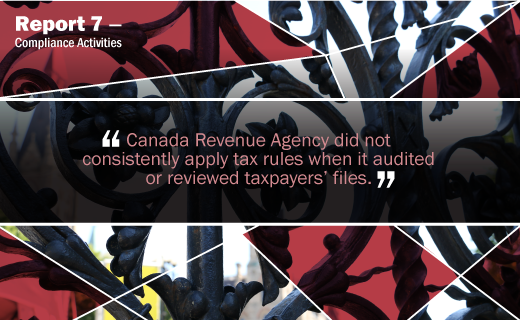Report 7—Compliance Activities—Canada Revenue Agency
At a Glance Report 7—Compliance Activities—Canada Revenue Agency
What we examined (see Focus of the audit)
Canada’s income tax system is based on self-assessment. This means that taxpayers must submit income tax returns to report their annual income, and they can claim deductions or credits that apply to their situations.
Part of the Canada Revenue Agency’s mandate is to ensure that taxpayers comply with the income reporting requirements of the Income Tax Act. The Agency aims to protect the integrity of the tax system by identifying and deterring those who do not comply.
This audit focused on whether the Canada Revenue Agency applied the Income Tax Act consistently during compliance activities and accurately reported the results of its compliance activities. We examined how consistently the Agency applied its compliance activities for various types of taxpayers across Canada. We also examined the performance indicators for compliance activities and how they were measured, monitored, and reported to Parliament.
Why we did this audit
This audit is important because the Agency’s own Taxpayer Bill of Rights gives all taxpayers the right to have the law applied consistently. It also gives all taxpayers the right to receive entitlements, such as benefits, credits, and refunds, and to pay no more and no less than what is required by law.
It is also important for parliamentarians and the public to have complete and transparent information. They need to assess whether the Agency is meeting the government’s objective to crack down on non-compliant taxpayers, so that all taxpayers pay the right amount of taxes.
Overall message
We found that the Canada Revenue Agency did not consistently apply tax rules when it audited or reviewed taxpayers’ files, even though the Taxpayer Bill of Rights includes the right to have the law applied consistently.
There were a number of reasons for these inconsistencies. They included the judgment of Agency staff conducting compliance activities; the region where the file was reassessed; and the type of taxpayer—for example, a small business or a large corporation. Taxpayers in one region waited an average of 7 months longer than those in another region for the Agency to complete an audit. In one region, it took the Agency more than 40 weeks to process taxpayers’ requests for adjustments, while in another region, the Agency took 12 weeks.
We also found that the additional revenue the Agency reported as a result of its compliance activities reflected taxes owed by taxpayers but did not reflect the taxes that it could not collect from taxpayers. This means that the impact on the government’s fiscal results was significantly less than what the Agency estimated. Furthermore, the Agency’s targets for additional revenue it can earn from compliance activities have increased over the past few years, which indicates that there were still significant areas where taxpayers either did not comply or did not know how to comply.
What we found about …
Performing compliance activities
Managing and reporting on results
Entity Responses to Recommendations
The entity agrees with our recommendation(s) and has responded (see List of Recommendations).
Related information
| Report of the | Auditor General of Canada |
|---|---|
| Type of product | Performance audit |
| Topics | |
| Entities | |
| Completion date | 18 September 2018 |
| Tabling date | 20 November 2018 |
| Related audits |
|
For more information
Media Relations
Telephone: 1-888-761-5953
E-mail: infomedia@oag-bvg.gc.ca
Twitter: OAG_BVG
